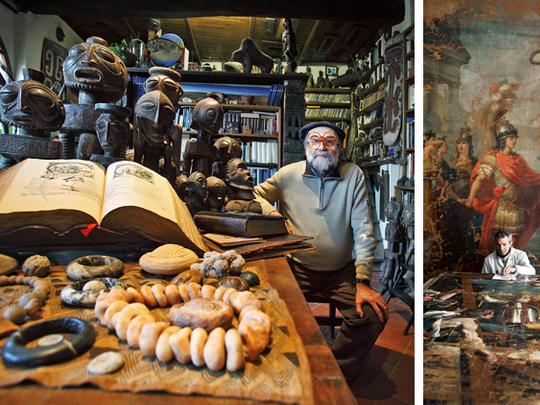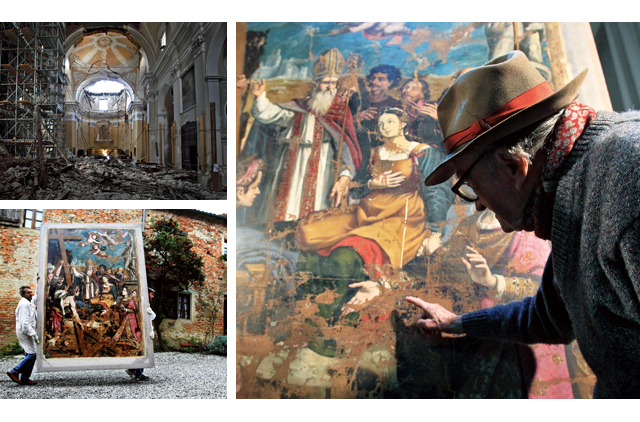
The Bedeschini? It’s in the basement. Do you want to see it again?” Anna Rosa Nicola puts her brushes and palette down and pulls the iPod earphones from her ears. The four-metre-high painting in front of her depicts a not-quite fully restored Saint Lawrence roasting on the grill; the agony of his martyrdom painted by the world-famous Titian.
But true love is not generally impressed by prestige or big names. The Titian – its restoration paid for by an art-loving bank as a promotional exercise – must wait. For now the attention returns to Bedeschini, the unprofitable labour of love. In her flapping white work coat, the 54-year-old art restorer leads me through the garage of the family business.
Bedeschini who? He was a Baroque painter, one almost no one has heard of. Even Anna Rosa, who has been working with paintings for almost 40 years, admits his name meant nothing to her at first.
Now the Piedmontese expert on Giulio Cesare Bedeschini has learned that he worked exclusively in the area of L’Aquila around the end of the 16th century, he was a disciple of Cigoli, and he painted in the bombastic style of the Counter-Reformation. But before she could discover any of this, the earth first had to shake.
Huge tremors shook the southern Italian region of Abruzzo in April 2009. More than 300 people died, and the old town of L’Aquila, with its Renaissance palaces and baroque churches, collapsed into a giant heap of rubble.
Among the dusty ruins of the church of San Francesco di Paola, rescue workers carefully retrieved a painting. The artwork was severely damaged: the canvas had become wrinkled and hard, and there were countless holes and cracks. The damage was so severe they couldn’t straighten it out, otherwise the paint would have fallen off.
“It wasn’t a picture any more,” sighs Anna Rosa with a voice that still resonates with shock. The work had depicted the finding of the True Cross, but there wasn’t much left to see. Nevertheless, the signature could still be deciphered: Bedeschini.
Now the Finding of the True Cross lies on a table in the Nicola family workshop in Aramengo, a village of 600 people to the east of Turin. Anna Rosa has set it upright and watches closely through her black Chanel glasses as a co-worker takes a yogurt pot of beige primer and dabs between the exulting angels in the upper right corner.
It almost looks like a painting again. It is still a little pale – the retouching of the colours has not quite been completed – but it is out of the woods. The problem child has weathered the storm of a deathbed fever, and will soon rise again.
The restorers fixed the crumbling paint with four layers of Japanese paper. They smoothed the painting out using steam, applied a new canvas to the back, patched up the holes on the front using historic fabrics, and made a new frame.
Work on the painting has been costly – the Soprintendenza delle Belle Arti, the Superintendency of Fine Arts in the Abruzzo region, put the cost at €20,000 (Dh96,500) – but the Nicola family has asked for nothing in return. They do it for the love of art and in part for L’Aquila, which has already been forgotten by politicians and the public.
Anna Rosa and her husband Nick Pisano, also a restorer, travelled to the south to “adopt” the damaged work of art, as one foundation described it. Their choice was more difficult than expected.
“It was like being in an animal shelter,” Anna Rosa recalls. “We would have liked to have taken them all home.” The Bedeschini won their hearts because it had been affected worst of all. “Love at first sight,” the restorer says. Then she adjusts her work coat, plugs King Crimson back into her ears, and returns to Titian. Duty calls.
The Nicolas’ village, Aramengo, is located in the sleepy hills of the Basso Monferrato, slightly above the poplar groves and oak forests, and is accessed via a patched-up asphalt road on which tractors and cyclists form the majority of the traffic. But don’t be deceived by its apparent remote location.
It is only one hour’s drive from Turin, and Nicola Restauri, housed in several villa-style brick buildings with white-painted lattice windows, is one of the largest and most prestigious operations in the Italian art restoration business. Masters like Rubens and Tintoretto are often entrusted to them.
Not a bad state of affairs when you consider the company started in the back room of a barber’s shop in the centre of Turin. That was where Guido Nicola, now 91, practised his art of restoration in the years following the Second World War after a full working full day of trimming hair and clipping moustaches. He bought damaged paintings for a few lire at the local flea market.
Guido was a poor village boy from Aramengo. The youngest of seven siblings, he had to leave school after fifth grade in order to earn a living. To set up as a barber he sold his family’s only cow. But Guido’s real enthusiasm and talent was saved for the work in the back room. He was successful; he started a family; the orders multiplied; and soon space was at a premium.
As children, Anna Rosa and her brother Gian Luigi had paintings hung out to dry dangling over their beds. When the Nicolas returned to Aramengo in the 1970s due to space limitations, they brought 13 employees with them.
Guido Nicola is still busy in the workshop every day. A small, very old man, he walks through the rooms with hands folded behind his back, inspecting the progress of work through thick-lensed glasses, politely asking visitors if they want a cup of coffee.
The workshop covers 3,500 square metres, and inside are 40 employees in white coats, all familiar with just about everything: frescoes and oriental works, parchments and terracotta, wood and textiles, and contemporary art and ancient Egypt. It’s as colourful and diverse a collection as you might hope to find in any museum.
The Titian is propped up in a 12-metre-high workshop, which contains an overhead crane, and stages and platforms just like a large theatre. Along one wall are shelves lined with hundreds of glass jars stacked on top of one another, containing shimmering, antique colour pigments, with the finest nuances from Congo red to silk green. A few steps away is a casually pushed-aside Canaletto landscape, behind which is an Egyptian sarcophagus recently cured of woodworm.
Even these treasures are overshadowed by a huge, 50-square-metre master image for a tapestry depicting the Crucifixion. A church in Bergamo left it here and never picked it up.
“They don’t know where to put it,” says Gian Luigi, a specialist in Egyptian art, explaining a typical consequence of empty state coffers: completed jobs are often forgotten and left with the restorer, thus saving on storage costs. There’s also a mummy from the municipal museum in Asti: Poverina, the Poor One.
Even Bedeschini is threatened with homelessness, because his home church in L’Aquila is still a shambles. “But what can we do? Throw it out of the door?” Gian Luigi asks, shaking his head. “We are art lovers, not art dealers. Money is not so important. We do this with passion, but also as human beings.”














